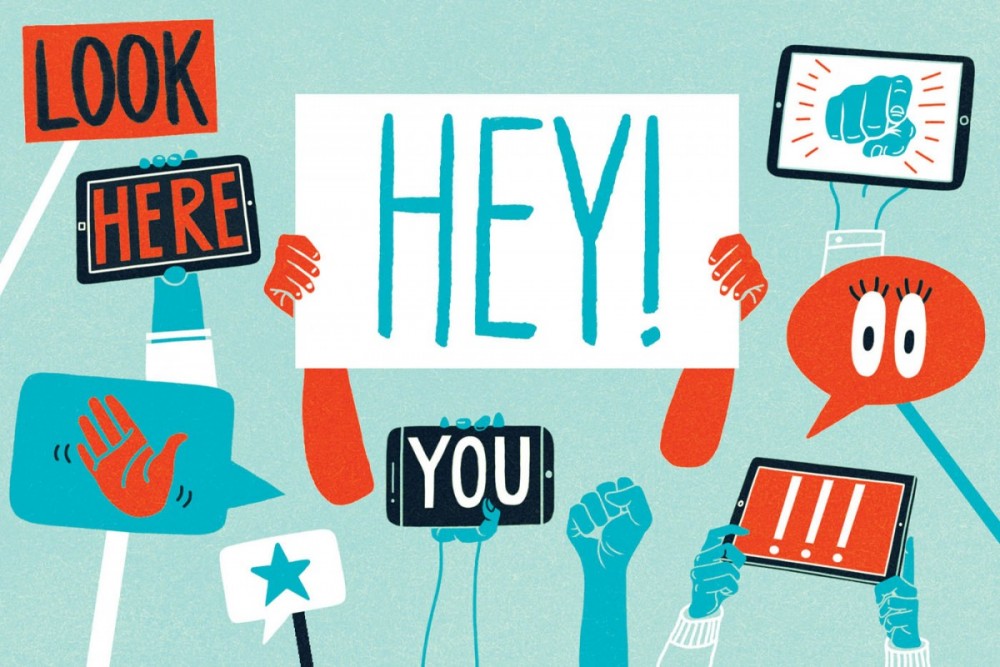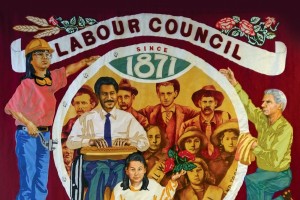How do unions “see” our members in the era of content marketing and surveillance capitalism? Do we see them as prospects to market to — or as agents of social change, to equip and organize?
Questions like these suggest that unions and other organizations face a digital conundrum in the age of surveillance capitalism: do we use digital technologies in logics of creativity and liberation or in logics of tracking, targeting and data collection?
A good marketer would say, “Don’t make me choose!” But, unless I’m missing something, I’m pretty sure the revolution will not be marketed, even if it might, in the end, be televised.
And I’m likewise pretty sure that there’s more to labour unions than marketing. At the same time, I am also very certain that we are struggling — as organizations and as a movement — with how to come to grips with digital’s creative possibilities on one hand, and, on the other, with how to “compete” for members’ attention in a world soaking in capitalist content. How do we do that without internalizing capitalist norms?
The war for attention is on, notes technology historian Tim Wu.
“Over the coming century, the most vital human resource in need of conservation and protection is likely to be our own consciousness and mental space,” Wu writes in The Attention Merchants, his entertaining and accessible survey of how advertisers and propagandists have metastasized to today's dizzying digital heights to harvest and sell our attention. Wu writes: "If we desire a future that avoids the enslavement of the propaganda state as well as the narcosis of the consumer and celebrity culture . . . we must act, individually and collectively, to make our attention our own again, and so reclaim ownership of the very experience of living."
I like this idea of acting collectively to make our attention our own again. It's a positive rejection of the neoliberal falsehood that individual "solutions" can solve collective problems. And, of course, unions are all about collective solutions, so it's heartening to find some that are embracing digital technological change while addressing organizational change as well.
Unions remain in a relatively strong position, with the necessary collective values and institutional and financial resources, to play a vital role in creating collective ways that we can make “our attention our own again” in the face of the shiny shitstorm of digital surveillance capitalism.
In speaking to digital publishers and union folks, some constant themes emerged. There’s no magic recipe for success, but there are some key ingredients:
• Find out what your members are interested in;
• Explore how to publish digital content in relevant ways;
• Provide online experiences that are deeply meaningful;
• Bridge your silos, and;
• Grow the in-house capacity to deliver the goods.
Unions may be struggling with digital, but not in vain. They are rediscovering their core purpose while providing real digital relevance to their members and their communities. We can take inspiration from unions, some described here, that are lighting new digital pathways of connection for current and upcoming generations.
UNIONS AS DIGITAL PUBLISHERS
Unions are starting to take seriously the idea that we are organizations, yes, but we are also simultaneously digital publishers about the work we do as unions.
So, how do we raise our game as digital publishers? The answers are complex and political for each union, depending on their sector, history, culture, internal and external challenges.
Thinking like a magazine might help.
Melony Ward has worked in media, arts and culture for decades, much of that in magazine publishing. Currently the publisher for Canada’s History magazine, Ward recently shared with me some insights into digital publishing that unions could benefit from.
Ward encourages not-for-profits like unions to develop their web content from the point of view and interests of the user, rather than those of the organization.
“If the communications strategy is organized in terms of your own internal silos, it may not interest the reader,” Ward says. Indeed, most union websites reflect this inside-out approach where they present visitors with detailed information about their organizational departments. There are options, Ward says.
“If your public-facing digital content is organized in a magazine format, it’s going to give the user different entry routes.”
Organizing the stories into a magazine-style Table of Contents is a format that has worked for ages in radio and television as well as in other media, she says.
For Ward, success depends on figuring out how to dialogue with your audience (or your members), instead of communicating the needs of your organization’s different departments, one-way, from the inside-out.
This shows people that “you’re thinking about them, and not about yourself,” she says.
Thinking about our members — seeing them — remains a fundamental principle of engagement, whether online or off. And thinking about them means finding out what their interests, needs and concerns actually are.
Some unions are doing just that.

ILLUSTRATION: PUI YAN FONG
ORGANIZING IN RELEVANT WAYS
“We use technology to survey our members about the issues that matter to them — rank-and-file members, not just activists and elected leadership,” says Emet Davis, director of research and interactive services at the British Columbia Government and Service Employees Union (BCGEU).
“It’s a combination of personalized digital communications with a modern organizing model — which, ironically, is traditional grassroots relationship-building,” Davis says. “This is really our vision of a modern union movement — what we would call social movement unionism.”
Davis stresses the importance of fostering face-to-face conversations with members and organizing in relevant ways, like offering courses, workshops and family events.
In fact, BCGEU re-imagined its entire educational program to support its organizing model, Davis says. Hugely popular, the program features courses and workshops on personal growth (including yoga and bicycle maintenance), on work topics (including mental health and resume writing) and on union leadership (including stewarding, local leadership and running for office). The program is supplemented by digital offerings, but the member-to-member work is the ground everything is built on.
“All of these are . . . very traditional ways to re-engage with our membership,” she notes.
It’s paying off. The response to union events, workshops and conferences has been incredible. A BCGEU-organized family day at the Royal BC Museum in Victoria drew over 475 members and their families.
“We were stunned by these rates of registration,” Davis says about the museum event, an “old-school” union activity meant to deepen members’ sense of connection to their union. “That’s the cultural shift, and that’s more than just a personalized communication, it’s much deeper than that: it’s face-to-face.”
Davis credits her union’s leadership, in particular president Stephanie Smith and treasurer Paul Finch, for guiding a cultural and digital shift at the organization that is taking BCGEU “back to our roots of social unionism.”
The union is extending this analogue revolution into its digital spaces as well, balancing technological change and organizational change.
BCGEU has been steadily building capacity over the past few years. First, they asked the IT department to create the digital infrastructure the organization needed — and gave it a mandate to collaborate with other departments (something that doesn’t always happen in our organizations). At the same time, the union has built up its digital capabilities by hiring communications staff who bring those skills — and by supporting two-way mentorship and skills-sharing between senior and newer staff.
Currently, BCGEU is shifting to a new project-management model that brings teams from across the organization, including elected leadership, to work together. The union’s elected leaders bring subject-matter expertise to do with their sectors, Davis says, and staff bring expertise around different forms of communication.
“That’s what makes for such a dynamic and collaborative approach to what we’re doing.”
BCGEU’s example is exciting. Davis and her colleagues have much to share with the wider labour movement about how unions can balance technological change, organizational change and social change.
Building capacity like this strengthens our organizations in numerous ways, including how to better tell our own stories.
That’s good news, because unions have the absolute best stories.
AT THE HEART OF IT ALL: STORY
Union stories have all the good bits: the stuff of real people working together to stand up, collectively, to overcome challenges. Workers celebrate victories, suffer defeats, and get organized to give’r all over again.
But these days, if a story falls in the forest, and there isn’t a smartphone around to capture it on video, does it really fall? Unions, like all organizations, are confronted with the need to tell our stories in new ways — including with video.
Cough. Okay, video isn’t that “new.” But what is new-ish is how video now totally dominates online media consumption. All of us, including our members, are watching more video than ever before. That’s why it’s counter-intuitive that in-house video production remains a rarity for Canadian unions.
There are lights and cameras and action on set, however: in-house video capacity is growing in our organizations. Union staff are taking the initiative to develop their own video filming and editing skills.
And several unions, including BCGEU and the Ontario Public Service Employees Union (OPSEU), have gone further to bring video production in-house by creating dedicated videographer positions in their communications departments. (It would be great to hear from other unions also doing this.) Part of the videographer’s role at BCGEU, Davis tells me, is to support skills-sharing so more people can acquire video-publishing skills.
Unionists outside of communications departments are also using video to tell stories. Irene Jansen, in her work as a human rights officer at the Canadian Union of Public Employees (CUPE), uses digital storytelling approaches to help members tell their own stories with pictures, audio and video.
“Digital storytelling helps members reflect on an issue, deepen their analysis and learn how to hone stories for organizing, media, presentations and other forms of communication,” she tells me.
In digital storytelling, “members tell personal stories to educate others, recruit new activists and motivate people to take action,” Jansen says.
Building video capacity is an essential way to strengthen unions’ ability to tell our stories, ourselves. Unions are also building capacity to share knowledge — which is smart, because offering our members online learning opportunities that they want or need is a great way to demonstrate union (and digital) relevance.
The United Food and Commercial Workers (UFCW Canada) has been doing it for years.
BEING PART OF OUR MEMBERS' JOURNEYS
“Finding ways to have practical solidarity in this world is something that the union movement continues to struggle at,” says Marv Funk, education director at UFCW Canada.
That’s why WebCampusPlus, UFCW’s online learning platform, is open to all its members — and their families. To date, the program has helped a whopping 40,000 working people open up educational opportunities they otherwise may not have had access to. This helps members, their families and their communities see that the union is a “good deal,” Funk says.
“A lot of our members work in honest jobs that don’t require a post-secondary education,” he says. “WebCampus can be that bridge, if they’re looking for options and college and university price tags continue to be ridiculous. WebCampus becomes a very worker-friendly approach to education.”
The program was started in the late 1990s by UFCW Locals 175 & 633, and was taken up by the national union in 2008. To date, WebCampusPlus has offered over 150 courses in English and another 50 in French. Every year, thousands of members take courses in six main areas: labour studies, computers and technology, food and retail, health and safety, skills development and personal growth.
Internally, Funk and his education colleagues “continue to eliminate silos” and collaborate with other departments (he mentions human rights, communications and political action) to create course strategies and materials.
Funk points out that online learning should not be used to cut face-to-face learning programs in our unions. “Both are integral to education,” he says. But context matters. UFCW membership, like that of many unions, is spread all over the country, including in rural areas. “Getting people in the door for training is a barrier, and we can eliminate that barrier with WebCampus.”
Funk says the program has “absolutely” strengthened members’ connection and affinity with their union.
“With members who take our courses, a trust relationship has developed,” he says. “They get graded; they pass or don’t pass. But, we’re on their side. If they don’t pass, we ask them how we can support their learning. We want them to succeed, and they want to earn what they get. We want to be part of their journey as they go.”

ILLUSTRATION: PUI YAN FONG
SOLIDARITY IN THE CLOUD
In recent years, unions have launched broadly organized efforts to strengthen “member engagement” and bolster “face-to-face conversation skills.” These programs have been mostly sincere, if not always fully realized, and they remain top priorities for union capacity building.
At the heart of these efforts is the idea that we need to rebuild, in analogue ways, our members’ sense of connection to, and affinity with, their unions. And it’s true; we do. We also need to do that in digital ways.
Digital solidarity can be demonstrated with our members, with each other as union staff and leadership, and with our communities:
- We demonstrate member digital solidarity with those who belong to the union by designing our communications around their needs, concerns and interests — and by supporting their growth with digital experiences that are relevant, useful and accessible, like UFCW’s online learning program.
- We demonstrate organizational digital solidarity when we work well together as union staff and leadership to create and deliver good content, when we bridge our silos, collaborate and “find new ways of talking together,” as the CLC's Laurie Antonin says.
- And unionists demonstrate social digital solidarity in our communities and in online spaces when we interrupt oppression on one hand, and, on the other, when we support the community-based building of skills and critical knowledge.
In short, we demonstrate digital solidarity when we make union content relevant again and step up the broad social unionism fight for racial, social and economic justice.
Digital relevance requires us to use our own websites and email lists, for sure, and even social media. But the war for attention demands more from our organizations. It demands that we build in-house digital studios and expand the space to explore, create and take chances as we generate digital relevance for our members. It demands we deepen and extend notions of solidarity into our digital work — as producers, educators and organizers.
Clearly, kicking butt with witty email updates, worker-friendly online learning programs and house-made explainer videos won't “solve” the problem of the surveillant, commodified web. Tactics alone won’t help us win the war for attention.
But building digital relevance with our members, using tools we control, and demonstrating values we hold dear will greatly enhance our ability to fight.
And what, finally, would Han Solo say?
“Bring ‘em on,” is what he’d say. “I prefer a straight fight to all this sneaking around.”
Digital relevance flows from labour’s grounded normativity of solidarity. We can learn from these examples and be inspired to work together to move social unionism into the digital era, inside and outside our organizations.
It’s working for BCGEU, where Emet Davis and her colleagues are striking the balance between technological change, organizational change and social change.
“People,” Davis says, “are going back to the union hall.”
♦ ♦ ♦
BCGEU’s TIPS FOR OTHER UNIONS
- Keep members at the centre of what you do;
- Don’t be afraid of change;
- Bring in great talent;
- Adopt the best technology;
- Keep up-to-date;
- Support cross-training and sharing of resources and skills.
UFCW’s TIPS FOR OTHER UNIONS
Different unions will have different needs or goals when it comes to integrating online learning into their content strategy. Here, Marv Funk provides some key tips that can help other unions think things through. You’ll notice a repeating theme in this article with the first tip!
- Find out what the members are actually interested in, and what they want to learn from you;
- Build relationships with them;
- Start small, and be realistic;
- Shop around for a good platform that meets your needs (beware of upselling);
- Web tech is changing constantly — jump in and manage it properly.
Five free tips for digital publishing
1) Purpose first
Ever doubted the utility or effectiveness of an initiative? You’re in very good company. Sometimes, we do things a certain way because that’s the way we’ve always done them, and we don’t always ask why. Defining the purpose of any task or initiative is a sure way to interrupt stale publishing patterns. Asking simple questions takes us back to our first principles — or helps us articulate them in the first place.
2) Raise your (editorial) voice
A clear editorial voice acts as the “host” for your members’ journeys on your website, email newsletters or social media. “Most media brands use a magazine approach,” notes digital publisher Melony Ward, “and they use strong editorial voices as the host for the journey.” Unions can play host, too, by publishing content with a specific “voice” that relays the spirit of what the union is about. That voice (and that spirit) can be dour, formal and rigid. Better if it’s conversational, helpful and bright.
3) Email ain’t dead
Platforms come and go, but email remains a top way to stay in touch. Making better use of email is a major opportunity for most unions. Unions have access to members’ email addresses — use them, says the CLC’s Laurie Antonin. “Think about all the emails you get about things you care about,” advises Antonin. “Think about the kind of relationship you want to build with your members and create content that will get their attention.” Keep your email newsletters informal, brief and relevant. Link back to resources on your website or to other online resources.
4) Teach where you are (or, Teach with what you’ve got)
Any union can employ online learning as part of their content strategy. It’s all in the presentation. At its core, online learning material is information and knowledge organized and presented in an accessible way for the benefit of the learner.
You don’t need a fancy learning management system (LMS). You can create a functioning online course from simple web pages and a creative approach to using web tools, like the CLC did with its online learning program for young workers, Taking Charge of Change. Organize the information (or “learning objects”) in each lesson by using a simple template: RWAD — Read, Watch, Attend, Do. Read this article; watch this video; attend this event (a webinar or live event); and take an action (online or face-to-face) based on what you’ve learned.
5) Get some (mobile) perspective
More and more Canadians are accessing the web with a smartphone, according to the 2018 “Internet Factbook” published by the Canadian Internet Registration Authority (CIRA), growing from 58 per cent of Canadians in 2016 to 72 per cent in 2018. Look at your union’s website with your own mobile device, from the imagined point of view of an average member. Does the site respond well to the smaller screen? Does it invite (or repel) a casual visitor? What grabs the reader? Does the site do what you think it does? Getting perspective is free, but making changes to your site’s design and development won’t be. It’s money well spent. — D.R.
This is Part Two of a two-part article. Part One appeared in Our Times’ Fall 2018 issue.
David Robbins is a writer, union communicator and settler living and working on unceded Algonquin Anishnaabe territory in Ottawa-Gatineau. He is part of a growing co-conspiracy to shadowforge a future.















